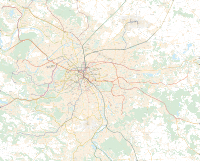Paris Métro Line 14
Paris Métro Line 14 (French: Ligne 14 du métro de Paris) is one of the sixteen lines on the Paris Métro. It connects the stations Saint-Lazare and Olympiades on a north-west south-east diagonal across the centre of Paris. It was operated completely automatically from the beginning, and the very positive return of that experiment motivated the retrofitting of Line 1 for full automation. Before being put into commercial service Line 14 was known as project Météor, an acronym of MÉTro Est-Ouest Rapide.
| Line 14 | |||||||||||||||||||||||||||||||||||||||||||||||||||||||||||||||||||||||||||||||||||||||||||||||||||||||||||||||||||||||||||||||||||||||||||||||||||||||||||||||||||||||||||||||||||||||||||||||||||||||||||||||||
|---|---|---|---|---|---|---|---|---|---|---|---|---|---|---|---|---|---|---|---|---|---|---|---|---|---|---|---|---|---|---|---|---|---|---|---|---|---|---|---|---|---|---|---|---|---|---|---|---|---|---|---|---|---|---|---|---|---|---|---|---|---|---|---|---|---|---|---|---|---|---|---|---|---|---|---|---|---|---|---|---|---|---|---|---|---|---|---|---|---|---|---|---|---|---|---|---|---|---|---|---|---|---|---|---|---|---|---|---|---|---|---|---|---|---|---|---|---|---|---|---|---|---|---|---|---|---|---|---|---|---|---|---|---|---|---|---|---|---|---|---|---|---|---|---|---|---|---|---|---|---|---|---|---|---|---|---|---|---|---|---|---|---|---|---|---|---|---|---|---|---|---|---|---|---|---|---|---|---|---|---|---|---|---|---|---|---|---|---|---|---|---|---|---|---|---|---|---|---|---|---|---|---|---|---|---|---|---|---|---|
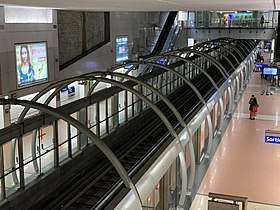 | |||||||||||||||||||||||||||||||||||||||||||||||||||||||||||||||||||||||||||||||||||||||||||||||||||||||||||||||||||||||||||||||||||||||||||||||||||||||||||||||||||||||||||||||||||||||||||||||||||||||||||||||||
| Overview | |||||||||||||||||||||||||||||||||||||||||||||||||||||||||||||||||||||||||||||||||||||||||||||||||||||||||||||||||||||||||||||||||||||||||||||||||||||||||||||||||||||||||||||||||||||||||||||||||||||||||||||||||
| System | Paris Métro | ||||||||||||||||||||||||||||||||||||||||||||||||||||||||||||||||||||||||||||||||||||||||||||||||||||||||||||||||||||||||||||||||||||||||||||||||||||||||||||||||||||||||||||||||||||||||||||||||||||||||||||||||
| Termini | Saint-Lazare Olympiades | ||||||||||||||||||||||||||||||||||||||||||||||||||||||||||||||||||||||||||||||||||||||||||||||||||||||||||||||||||||||||||||||||||||||||||||||||||||||||||||||||||||||||||||||||||||||||||||||||||||||||||||||||
| Connecting lines | |||||||||||||||||||||||||||||||||||||||||||||||||||||||||||||||||||||||||||||||||||||||||||||||||||||||||||||||||||||||||||||||||||||||||||||||||||||||||||||||||||||||||||||||||||||||||||||||||||||||||||||||||
| Stations | 9 | ||||||||||||||||||||||||||||||||||||||||||||||||||||||||||||||||||||||||||||||||||||||||||||||||||||||||||||||||||||||||||||||||||||||||||||||||||||||||||||||||||||||||||||||||||||||||||||||||||||||||||||||||
| Ridership | 83.3 million (avg. per year) 12th/16 (2017) | ||||||||||||||||||||||||||||||||||||||||||||||||||||||||||||||||||||||||||||||||||||||||||||||||||||||||||||||||||||||||||||||||||||||||||||||||||||||||||||||||||||||||||||||||||||||||||||||||||||||||||||||||
| Operation | |||||||||||||||||||||||||||||||||||||||||||||||||||||||||||||||||||||||||||||||||||||||||||||||||||||||||||||||||||||||||||||||||||||||||||||||||||||||||||||||||||||||||||||||||||||||||||||||||||||||||||||||||
| Opened | 15 October 1998 | ||||||||||||||||||||||||||||||||||||||||||||||||||||||||||||||||||||||||||||||||||||||||||||||||||||||||||||||||||||||||||||||||||||||||||||||||||||||||||||||||||||||||||||||||||||||||||||||||||||||||||||||||
| Operator(s) | RATP | ||||||||||||||||||||||||||||||||||||||||||||||||||||||||||||||||||||||||||||||||||||||||||||||||||||||||||||||||||||||||||||||||||||||||||||||||||||||||||||||||||||||||||||||||||||||||||||||||||||||||||||||||
| Conduction system | Automatic (SAET) | ||||||||||||||||||||||||||||||||||||||||||||||||||||||||||||||||||||||||||||||||||||||||||||||||||||||||||||||||||||||||||||||||||||||||||||||||||||||||||||||||||||||||||||||||||||||||||||||||||||||||||||||||
| Rolling stock | MP 89 CA (21 trains as of 3 November 2013) MP 05 (11 trains as of 20 March 2016) | ||||||||||||||||||||||||||||||||||||||||||||||||||||||||||||||||||||||||||||||||||||||||||||||||||||||||||||||||||||||||||||||||||||||||||||||||||||||||||||||||||||||||||||||||||||||||||||||||||||||||||||||||
| Technical | |||||||||||||||||||||||||||||||||||||||||||||||||||||||||||||||||||||||||||||||||||||||||||||||||||||||||||||||||||||||||||||||||||||||||||||||||||||||||||||||||||||||||||||||||||||||||||||||||||||||||||||||||
| Line length | 9 km (5.6 mi) | ||||||||||||||||||||||||||||||||||||||||||||||||||||||||||||||||||||||||||||||||||||||||||||||||||||||||||||||||||||||||||||||||||||||||||||||||||||||||||||||||||||||||||||||||||||||||||||||||||||||||||||||||
| Track gauge | 1,435 mm (4 ft 8 1⁄2 in) standard gauge with roll ways for the rubber tired wheels outside of the steel rails | ||||||||||||||||||||||||||||||||||||||||||||||||||||||||||||||||||||||||||||||||||||||||||||||||||||||||||||||||||||||||||||||||||||||||||||||||||||||||||||||||||||||||||||||||||||||||||||||||||||||||||||||||
| Electrification | 750 V DC guide bars on either side of the track | ||||||||||||||||||||||||||||||||||||||||||||||||||||||||||||||||||||||||||||||||||||||||||||||||||||||||||||||||||||||||||||||||||||||||||||||||||||||||||||||||||||||||||||||||||||||||||||||||||||||||||||||||
| Average inter-station distance | 1,075 m (3,527 ft) | ||||||||||||||||||||||||||||||||||||||||||||||||||||||||||||||||||||||||||||||||||||||||||||||||||||||||||||||||||||||||||||||||||||||||||||||||||||||||||||||||||||||||||||||||||||||||||||||||||||||||||||||||
| |||||||||||||||||||||||||||||||||||||||||||||||||||||||||||||||||||||||||||||||||||||||||||||||||||||||||||||||||||||||||||||||||||||||||||||||||||||||||||||||||||||||||||||||||||||||||||||||||||||||||||||||||
The line is also occasionally used as a showcase for the expertise of the RATP, its operator, and Systra and Siemens Transportation Systems, constructors of the rolling stock and automated equipment respectively when they bid internationally to build metro systems. In March 2014 the first of 18 MP 05 trains went into revenue service on Line 14. The STIF purchased these trains to improve service along the line and prepare the extension to the north in 2017. These trains will continue to enter service through 2015.[1] The line is expected to be part of the Grand Paris Express rapid transit network and to be extended north and south for this project.
Chronology
- 15 October 1998: The new Line 14 was inaugurated between Madeleine and Bibliothèque F. Mitterrand.
- 16 December 2003: Line 14 was extended north from Madeleine to Saint-Lazare.
- 26 June 2007: Line 14 was extended south from Bibliothèque François Mitterrand to Olympiades.[2]
- 3 March 2014: The first of eighteen MP 05 railcars goes into revenue service.
Development
The Météor Project
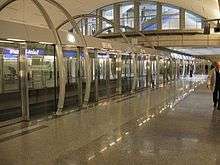
The original line 14 linked Invalides with Porte de Vanves until 1976, when it was merged into the southern section of the current line 13.
Paris's east–west axis across has long been heavily travelled: Line 1 of the Métro began approaching saturation in the 1940s, necessitating the construction of Line A of the RER in the 1960s and '70s; which became the busiest urban routes in Europe (by 2010 there were more than a million passengers each working day). To improve service, the SACEM (Système d'aide à la conduite, à l'exploitation et à la maintenance --"Assisted driving, control and maintenance system") was installed on the central run of Line A in September 1989. This improved efficiency and reduced the interval between trains to just two minutes, though an improvement ultimately insufficient to absorb the increasing demand. To cater permanently to demand on the busy artery between Auber and Gare de Lyon new rail lines would have to be built.
Two proposals were made by the transport companies: the SNCF suggested a new tunnel between Châtelet and Gare de Lyon for Line D of the RER allowing traffic to circulate from the north and south-east of Île-de-France. More importantly it proposed "Project EOLE" ("Est-Ouest Liaison Express"), the creation of a new standard gauge line, initially from Paris's eastern suburbs to Saint-Lazare, then an extension onwards to the western suburbs.
In 1987, the RATP proposed "project Météor", ("MÉTro-Est-Ouest-Rapide") the creation of a new Métro line, from Porte Maillot on the edge of the 16th arrondissement to the Maison Blanche district in the 13th, an area poorly served by transport despite its large population. The project would fit well with the regeneration of the Tolbiac district on the left bank around the new Bibliothèque Nationale de France, in that arrondissement.
The plans to go to Porte Maillot were eventually abandoned in favour of a terminus at Saint-Lazare, with the later possibility of extending the line to Clichy and assimilating the Asnières branch of Line 13, thus simplifying its complicated operation.
This new line parallel to Line A took the opportunity to incorporate innovations on the rest of the network: the stations are larger and, at 120 metres, longer and thus can accommodate eight carriages. The runs between stations are longer, allowing a rolling speed of close to 40 km per hour, close to double that of the other Paris metro lines and approaching that of the RER. Lastly, the line is completely automated and runs without any driver, the first large-scale metro line in a capital to do so (although driverless operation had been used on the VAL system in Lille and the MAGGALY technology of Lyon Metro Line D).[N 1]
Given the pressing need, the council of Ministers of Michel Rocard's government approved the project in October 1989. However, budgetary constraints forced the reduction of both. In the first stage, EOLE would be but a simple extension of trains from the suburbs to the new underground station at Saint-Lazare and MÉTEOR limited to the central Madeleine – Bibliothèque run, thus leaving the main railway station of Saint-Lazare and the heart of the 13th arrondissement unserved.[N 2] The tunnels were dug between 1993 and 1995. It was opened to the public in 1998 and had its first automatic run in October 1998.
Some features of Line 14's train control system are run under the OpenVMS operating system. Its control system is noted in the field of software engineering of critical systems because safety properties on some safety-critical parts of the systems were proved using the B-Method, a formal method.
Line 14 has some unusual design features – its floor tiling is not bitumenised, and platform screen doors at stations prevent passengers from falling onto the track or from committing suicide.
The southern extension of the line to Olympiades in June 2007, an area of high rise towers in the XIIIe arrondissement that was not served very well, was not a real extension: the tunnel was built at the same time as the rest of the line, but it was used as a train maintenance area, so a new maintenance area was constructed. The building of this extension caused the collapse of the courtyard of an elementary school; fortunately, no children were present on that day. Due in part to extensive mining for both gypsum and construction stone over two millennia, the underground of much of Paris is quite fragile and considerable care must be exercised before tunnelling work. (See Catacombs of Paris for further information.)
Construction begins
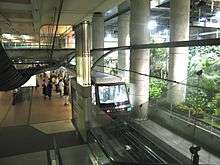
From November 1989 until the end of 1992 exploratory shafts and galleries were dug; tunnelling proper lasted from July 1993 until early 1995. In September 1993, Sandrine was baptised near la Bastille; a tunnel boring machine eighty metres (260 feet) long and eleven metres (36 feet) wide, it was capable of drilling a tunnel 8.6 metres (28 feet) across. Working twenty-four hours a day, five days a week, she bored twenty-five metres (82 feet) below the water table. The terrain, made mostly of loosely packed limestone and marl was favourable to drilling and the tunnel advanced at a respectable 350 metres (380 yards) a month. The tunnel passes underneath seven Métro lines, the sewers, Clichy-Capucines, and four underground carparks and passes over two RER lines.
Works at the site and the excavation of excavated material from the bassin de l'Arsenal were delayed two weeks by a flood of the Seine, the waterway route having been chosen to minimise heavy traffic in the city. The tunnel reached the future Pyramides station on 17 January 1995, and Madeleine on 15 March; it stopped underneath boulevard Haussmann in August and was brought to the surface through shafts there the same month.[N 3]
At the other end of the line, from Gare de Lyon to Tolbiac the tunnel was excavated directly from the surface. It crossed the Seine upstream from pont de Tolbiac, supported by submerged beams the traditional under fluvial support. The last was implanted on 28 September 1994.
As a cost-saving measure, the section from Gare de Lyon to the Bassin de l'Arsenal was excavated at the same time as the tunnels of Line D of the RER Châtelet–Les Halles. The 816,000 m3 (1,067,000 cu yd) of debris excavated is about twice the volume of the Tour Montparnasse, Paris's largest building; and the 19,000 tonnes (18,700 long tons; 20,900 short tons) of steel needed for re-inforced concrete and structural support is twice the mass of the Eiffel Tower.[3]
Extensions and incidents
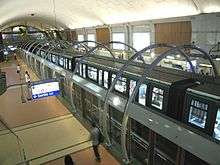
Traffic on the line grew quickly: in October 2003, after five years in service there were 240,000 daily passengers.[4] The same year service was interrupted several times to allow the installation of material for an extension north from Madeleine to Saint-Lazare. This section was opened on 16 December 2003, and the line saw a 30% increase in traffic thereafter; after Gare du Nord the northern terminus of Line 14 is the most important node on the network.
The southern extension, in June 2007, from Bibliothèque François-Mitterrand to Olympiades grew traffic again.[5] Initially planned for 2006, work was delayed by the collapse of the courtyard in the primary school at 11, rue Auguste-Perret during the night of 14–15 October 2006.[6][7] Since then traffic has grown again: at the end of 2007, on average 450,000 passengers took the line on a working day.
Travellers have been largely satisfied with Line 14's speed and service. However, despite its automation it has not been free of accidents. While the platform doors prevent access to the rails, they are susceptible to electric outages which have halted service entirely. On 20 September 2004, two trains stopped entirely in the tunnel after a signalling failure.[8] On 22 December 2006, passengers were trapped for one and a half hours after an electrical failure on the line which arose from a mechanical failure.[9] Technological failures have occurred twice: on 21 March 2007 traffic was interrupted between Gare de Lyon and Bibliothèque François-Mitterrand;[10] and again on 21 August 2007 a technical failure stopped service.[11]
Impact
The experience in automated control and doors has inspired several new projects. In 1998, the RATP began planning to automate several lines, despite the heavy cost. The automation of Line 1 began in 2007, along with the introduction of doors on the platform.[14] The upgrade was finished in 2012.[15]
The widespread introduction of platform doors for passenger safety is planned, despite the project's cost. In January 2004, ground level signalling to indicate the doorways was tested on Line 13 at Saint-Lazare station. Several different door models were tested during 2006 and Kaba was chosen to supply them. After testing, platform doors will be rolled out across the network, first in certain stations on Line 13, then on the totality of Line 1 in preparation for its complete automation.[S 1]
Technology
Signaling system
Météor as CBTC (Communication-based train control) system was supplied by Siemens Transportation Systems including monitoring from an operations control centre, equipment for 7 stations and equipment for 19 six-car trains, resulting in a headway of 85 seconds.[16]
It was the base for the Trainguard MT CBTC, which then equipped other rapid transit lines throughout the world.
Rolling stock
Line 14 uses rubber-tire rolling stock. Two types of trains are used: MP 89CA (21 trains as of 3 November 2013) and MP 05(11 trains as of 20 March 2016).
Plans are underway to de-place all stock on Line 14 with trains of class MP 14.
As of 2018, all trains contain six cars, but plans are in place to increase the size to eight cars (the Line 14 stations are designed to accommodate eight cars).
Future

As part of the Grand Paris Express expansion plans, Line 14 is being expanded both Northward and Southward.
Line 14 is being extended north from Saint-Lazare, with a principal aim of reducing overcrowding on line 13.[17] The adopted solution crosses the two branches of line 13 with stations at Porte de Clichy on the Asnières – Gennevilliers branch and Mairie de Saint-Ouen on the Saint-Denis branch. Another station will interconnect with the RER C station Saint-Ouen, another one with the Transilien Paris – Saint-Lazare lines at Pont-Cardinet, and the last one with the RER D at Stade de France – Saint-Denis. Construction on the extension began in 2014, with a target completion date in 2019.[18]
There are also plans to extend line 14 south towards Orly Airport. That extension would travel southeastward from Olympiades to Maison Blanche, with a possible connection to Line 7's Villejuif branch.
In February 2012 the STIF announced that, with the two extensions planned, a brand new class of rolling stock, the MP 14 will replace the current line of MP 89CA (and upcoming MP 05) stock along Line 14 around 2020. This new stock will consist of eight-car train formations, longer than used to date on the Métro, and the MP 89CA and MP 05 stock will be reassigned to other lines (including the possibility of Lines 4, 6, or 11, should they one day become automated).[19]
When both extensions are complete, it is expected that Line 14 will eventually be merged into the proposed Grand Paris Express system.[20]
Route and stations
Route

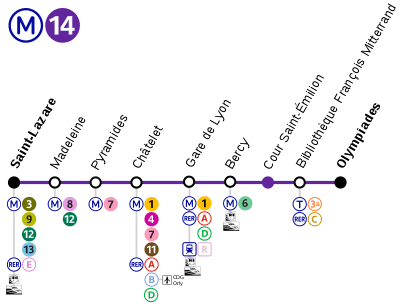
Line 14 has interchanges with the five lines of the RER, and quickly links Saint-Lazare with Gare de Lyon, via Châtelet. The line begins underneath Saint-Lazare in a two way tunnel-head, after stopping in that station, it heads southwards, descending beneath buildings and winding around Line 12 and RER Line A. It bends eastward and passes underneath Line 12, before entering, straight on, the station Madeleine, situated on the northern corner of the eponymous church, underneath the narrow rue de Sèze. The tunnel quickly descends on a 4.0% slope underneath Line 8, itself nestled underneath the boulevards de la Madeleine and des Capucines, Line 14 continues at this depth underneath the buildings above. The 794-metre journey to the station Pyramides finishes with a 4.5% climb to the station established just below l'avenue de l'Opéra.
Stations
| Station | Connections | observations |
|---|---|---|
| Saint-Lazare | Lines 3, 9, 12, 13 RER E Transilien Saint-Lazare Gare Saint-Lazare grande Line | |
| Madeleine | Lines 8 and 12 | near the Église de la Madeleine |
| Pyramides | Line 7 | named after Battle of the Pyramids and actually matching with the glass pyramids built in the Cour du Louvre |
| Châtelet | Lines 1, 4, 7 and 11 RER A, B and D | named after Place du Châtelet |
| Gare de Lyon | Line 1 RER A and D Transilien Lyon Gare de Lyon (national rail) | named after railway station to Lyon |
| Bercy | Line 6 Gare de Bercy (national rail) | |
| Cour Saint-Émilion | ||
| Bibliothèque François Mitterrand | RER C | named after François Mitterrand |
| Olympiades | named after Les Olympiades |
Architecture
The conceptual design of the stations sought to evoke space and openness. The size of stations, their corridors and transfer halls brings the line architecturally closer to those of the RER rather than the existing Métro lines. The RATP opted for a specific style of the new line, for instance lightly coloured tiling rather than bitumen. The use of space was designed in a contemporary manner: voluminous spaces mixed plenty of light with modern materials and overall eased the flow of passengers. According to the designers, the stations should be the reflection of a "noble public space, monumental in spirit, urban in its choice of forms and materials". Four architects designed the first seven stations on the line: Jean-Pierre Vaysse & Bernard Kohn six of them, and Antoine Grumbach &t Pierre Schall the station Bibliothèque.[S 2]
Saint-Lazare benefits from a well of natural light visible on the platforms, even though they are five levels below the surface. The station's exit is constructed from a glass bubble designed by Jean-Marie Charpentier and situated just in front of the Gare de Paris-Saint-Lazare, pointing towards the row of bus-stops.
Pyramides and Madeleine are endowed with a particular lighting, bright sunshine outside falls onto the platforms; a system which evidently does not work at night. Madeleine has several video projectors which allow cultural installations, for example, one on Marlène Dietrich, an actress, during the autumn of 2003.
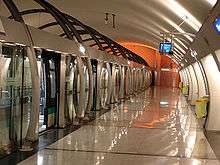
Gare de Lyon offers travellers the view of a tropical garden on the right side of trains towards Olympiades, as one enters the station. This garden is situated underneath RATP House at the foot of which the station was built. It occupies a space originally reserved for the Transport Museum. Moreover, it is the only station equipped with a central platform, the only possible layout in light of the density of underground construction in the area.
Bibliothèque François-Mitterrand has its own unique design: monumental, fifteen metre pillars and stairs forming a semi-circle seventy metres in diameter.
Olympiades station was developed by the architects Ar.thème Associés following the line's guiding principles, defined by Bernard Kohn from 1991. The station thus is in keeping with others in its choice of materials (polished concrete arches, wood on the ceilings, etc.) as much as in its lighting, height of its ceilings, and platforms larger than the average on other lines.
On the other hand, certain stations on the line are notable due to the disagreeable odour of humidity and sulfur that one can sometimes find as far as the changeover halls. Due to the line's relative depth, it runs underneath the water-table, creating a constant risk of seepage, similar to that found on Line E of the RER.[21]
See also
- Paris
- Transport in Paris
- List of stations of the Paris Métro
- List of stations of the Paris RER
- List of metro systems
- Rail transport in France
Notes
- (éd. 2004:135–136)
- p. 47
References
- "Ile-de-France : 14 rames MP05 de plus pour la ligne 14". 14 November 2012. Retrieved 19 March 2013.
- "New section of Metro Line 14 opened". InfraSite.net. 2 July 2007. Retrieved 6 July 2007.
- La Vie du Rail, "Météor: Les premiers pas du métro de l'an 2000", number 2507, 9 August 1995, page 16
- "Communiqué de presse RATP – La ligne 14 fête ses 5 ans !" (PDF). Archived from the original (PDF) on 3 June 2006. Retrieved 5 October 2011. (in French)
- Le Parisien, "Le métro compte une nouvelle station", 26 juin 2007
- "Conseil général des Ponts et Chaussées – Effondrement sur le chantier METEOR" (PDF). (824 KB), avril 2003
- "Une cour d'école s'effondre à Paris", l'Humanité
- "La couleur pourpre" Archived 4 September 2011 at the Wayback Machine
- "Les pieds dans la prise...", MétroPole, Archived 11 August 2011 at the Wayback Machine
- MétroPole – Coincé à faire un demi-tour Archived 4 June 2012 at Archive.today
- La ligne 14 du métro victime d'une panne informatique www.cio-online.com Retrieved 5 October 2011. (in French)
- Données de fréquentation : Statistiques 2005 du STIF, les transports en commun en chiffres, page 16
- Conseil du STIF du 8 février 2012 – Schéma directeur du matériel roulant pneu, p. 24
- MétroPole – Kaba prend les portes Archived 16 July 2010 at the Wayback Machine
- Siemens Transportation Systems – Nos réalisations, Paris – ligne 1, Siemens. Retrieved 4 October 2011(in French)
- "Driverless CBTC System for Line 14, Paris, France". Siemens AG. Archived from the original on 19 October 2006. Retrieved 9 July 2008.
- "Prolongement de la ligne 14 de Saint-Lazare à Mairie de Saint-Ouen" (in French). RATP. Retrieved 17 November 2011.
- "Grand Paris: le prolongement de la ligne 12 et 14 du metro retarde a deux ans", 23 October 2014, at Le Parisien (in French)
- "Archived copy" (PDF). Archived from the original (PDF) on 14 October 2012. Retrieved 14 October 2012.CS1 maint: archived copy as title (link) Modernisation du métro (in French). STIF. Retrieved 11 February 2012
- Grand Paris Express at symbioz.net (in French)
- MétroPole – Ce métro à l'odeur morose Archived 28 December 2011 at the Wayback Machine
- (in French) Special issue Naissance d'un métro (nouvelle ligne 14), La Vie du Rail magazine, October 1998 (see in the bibliography)
- pp. 7–9
- p. 10
- pp. 69–73
Bibliography
- (in French) "Naissance d'un métro (nouvelle ligne 14)". La Vie du Rail magazine (in French). Éditions La Vie du Rail (Special issue). October 1998.
External links
| Wikimedia Commons has media related to Paris Métro Line 14. |
| Wikivoyage has a travel guide for Paris. |
- (in French) RATP official website
- RATP English language website
- Interactive Map of the RER (from RATP's website)
- Interactive Map of the Paris métro (from RATP's website)
- (in French) Mobidf website, dedicated to the RER (unofficial)
- (in French) Metro-Pole website, dedicated to Paris public transports (unofficial)
- Paris Metro – Line 14 – St Lazare to Olympiades A passenger's video recording of a trip down the length of the line
- The French Meteor about the Météor project
